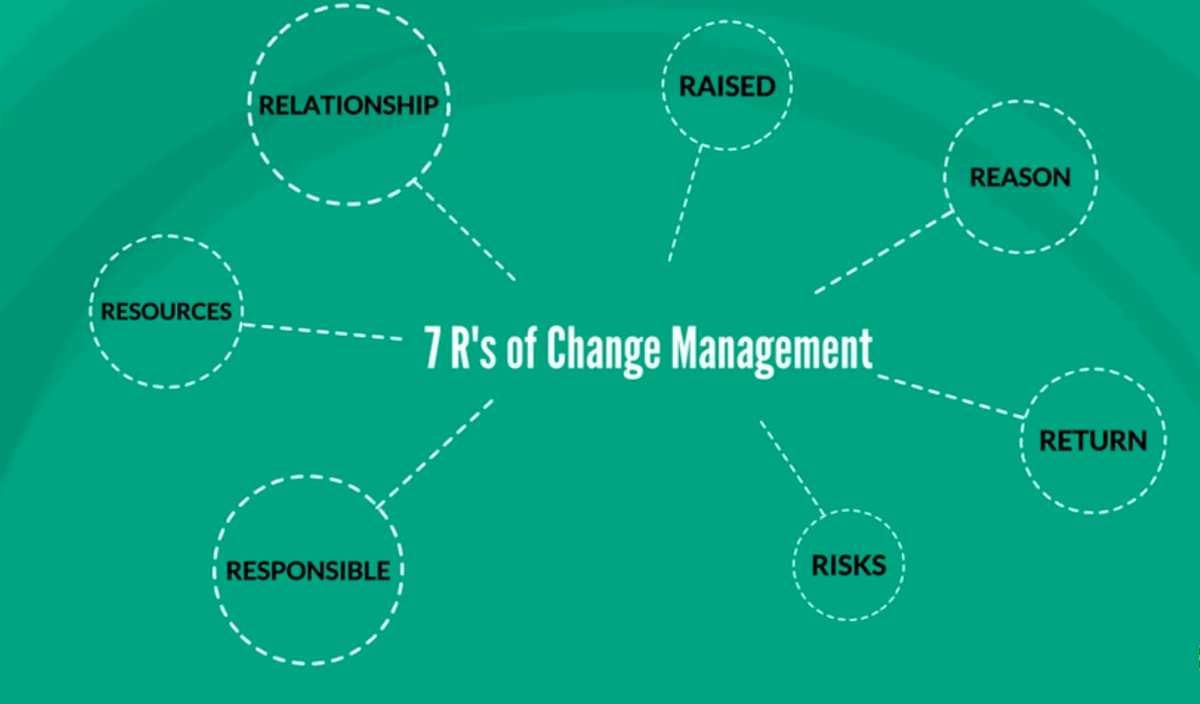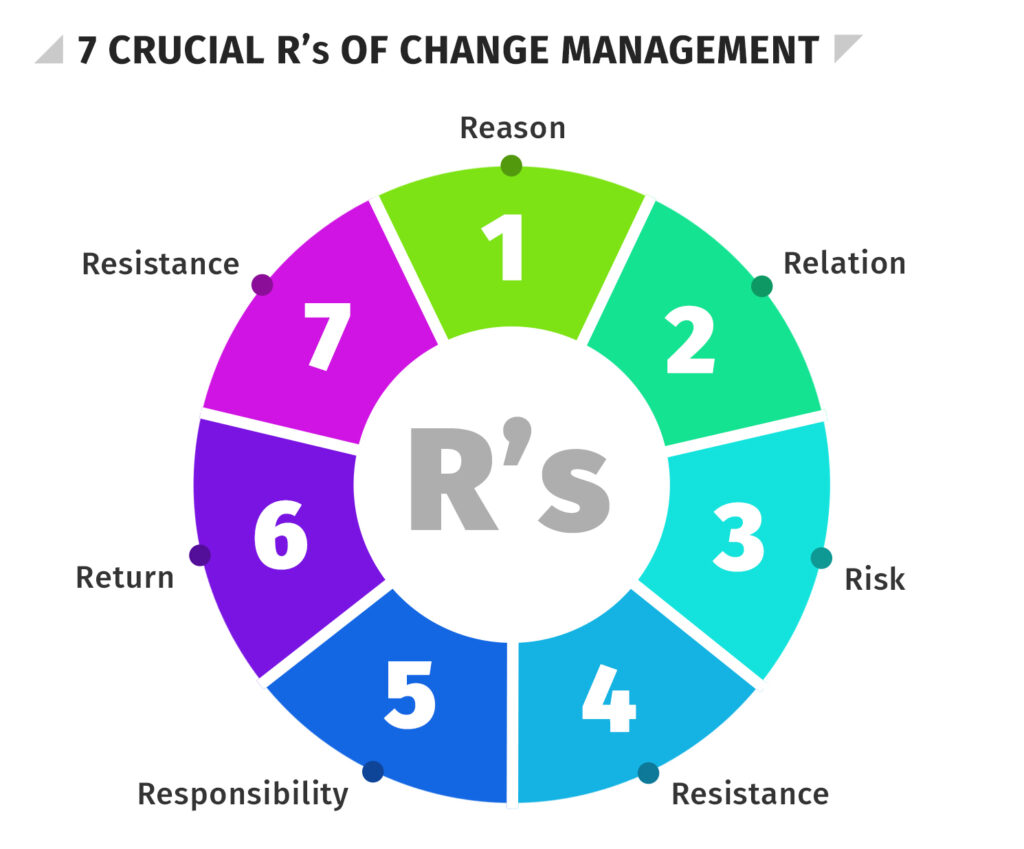What are the 7 R’s of change management?

What are the 7 R’s of change management?
Change is a part of life, and organizations need to adapt. Change management helps navigate these transitions, making it easier for everyone involved. The 7 R’s of Change Management is a useful framework for guiding change.
In this Atwork article, we’ll explore what the seven r’s of change management is and why it’s important. We’ll also break down the seven key elements of the 7 R’s framework, which can help both leaders and employees handle change effectively.
If you are interested in knowing more about change management, we have discussed this issue on a separate page, so I recommend that you visit that page before entering the discussion.

Types of Organizational Change
Here is some type of organizational changes:
Structural Change:
This involves altering the organizational structure, such as changes in hierarchy, departmental restructuring, or the introduction of new teams or divisions.
Cultural Change:
Cultural change focuses on transforming the values, beliefs, and norms within an organization. It often includes shifting towards a more collaborative, innovative, or customer-centric culture.
Technological Change:
This type of change involves adopting new technologies or upgrading existing ones. It can lead to process improvements, automation, and changes in how work is done.
Process Change:
Organizations frequently revamp their processes to improve efficiency and effectiveness. This can include reengineering workflows, streamlining operations, and implementing new methodologies like Six Sigma.
Strategic Change:
Strategic change pertains to shifts in an organization’s long-term goals, mission, or vision. It may involve entering new markets, exiting existing ones, or pursuing different business strategies.
Personnel Change:
Changes in personnel can include restructuring the workforce through layoffs, hiring, or training and development initiatives. Leadership changes and talent management strategies are also part of this type of change.
Product or Service Change:
Organizations often modify their products or services to adapt to evolving customer needs or market demands. This can involve launching new products, discontinuing old ones, or improving existing offerings.
Mergers and Acquisitions (M&A):
Mergers and acquisitions involve combining two or more organizations. This change type can lead to significant shifts in leadership, culture, and operations.
Financial Change:
Financial changes include alterations in budgeting, financial processes, and cost management strategies to ensure long-term financial sustainability.
Regulatory or Compliance Change:
Changes in laws and regulations can necessitate adjustments in an organization’s practices to ensure compliance. This can affect various aspects of the business, from reporting to product development.
Environmental and Sustainability Change:
Many organizations are embracing environmentally sustainable practices and striving to reduce their carbon footprint. This type of change involves adopting eco-friendly initiatives and integrating sustainability into their operations.
What are the 7 R’s of change management?
The 7 R’s of Change Management is a comprehensive framework that provides a structured approach to managing organizational change. This framework is particularly valuable when integrating transformation management software and implementing the change control process in software project management.
Let’s delve into each of the seven elements to understand their significance in navigating complex changes, especially within the context of software project management.

First R in the 7 R’s of change management?
Reason:
This first “R” underscores the critical importance of clearly defining and communicating the reasons behind the change. In the realm of software project management, this might entail explaining how implementing transformation management software can improve efficiency, enhance collaboration, or ensure compliance with industry standards. This clear rationale is key to garnering support from stakeholders and ensuring a seamless transition.
Return in the 7 R’s of change management
Return:
In software project management, the “Return” element is essential for quantifying the anticipated benefits of change. Utilizing transformation management software can yield a wide range of benefits, such as reduced development cycle times, increased software quality, and more effective project tracking. By articulating these expected returns, project managers can build a compelling case for change.
What is the meaning of risk in the 7 R’s of change management?
Risks:
Software projects often involve intricate technical dependencies, making the “Risks” element a critical consideration. Recognizing potential risks and uncertainties in the context of the change control process is vital. With transformation management software, identifying potential challenges early on and developing strategies to mitigate these risks can prevent costly setbacks during project execution.
Resources in the 7 R’s of change management
Resources:
In the software project management context, the effective allocation of resources, including financial, technical, and human resources, plays a pivotal role. Implementing transformation management software may require investments in tools, training, and skilled personnel. Ensuring that these resources are available and deployed optimally is essential for a successful change initiative.

What do we mean by roles in the 7 R’s of change management?
Roles:
Assigning well-defined roles and responsibilities is imperative in software project management. Clear delineation of responsibilities for using transformation management software, from project leaders to developers and quality assurance teams, can streamline the change process and reduce confusion.
Routines in the 7 R’s of change management
Routines:
The “Routines” element is particularly relevant in software project management. Implementing transformation management software often necessitates new workflows and processes. Adapting these routines efficiently and embedding them into daily operations can be instrumental in achieving the desired project outcomes.
What is the las R in the 7 R’s of change management?
Relationships:
Building and maintaining positive relationships is crucial, especially in software project management, where effective collaboration is a cornerstone. Open communication, trust, and collaboration among project teams, stakeholders, and external partners contribute significantly to the successful adoption of transformation management software and the smooth execution of the change control process.
Incorporating the 7 R’s of Change Management into software project management practices, with a focus on transformation management software and the change control process, can help organizations transition smoothly, minimize resistance, and ensure the successful delivery of software projects in an ever-evolving technological landscape.
Change Management Software for Software Implementation
Change management software is a critical component of successful software implementation, especially when it comes to business transformation and managing the change control process in software project management. This type of software is designed to facilitate and streamline the various aspects of change management in the context of software projects. Here’s an overview of how change management software is utilized in these scenarios:

Business Transformation Management Software:
Business transformation often involves significant changes in processes, technology, and organizational culture. Change management software tailored for business transformation helps organizations plan, track, and manage changes effectively. It assists in defining roles and responsibilities, tracking progress, and ensuring that the transformation aligns with strategic objectives.
Change Control Process in Software Project Management:
Change control is essential in software project management to ensure that modifications to project scope, requirements, or features are properly evaluated, approved, and managed. Change management software streamlines this process by providing a structured platform for documenting change requests, assessing their impact, and obtaining approvals. It helps maintain project consistency and minimizes scope creep.
Software Implementation Change Management Plan:
Change management software enables organizations to develop and execute comprehensive change management plans for software implementation. It assists in defining the rationale for the change, setting clear objectives, assessing risks, allocating resources, and specifying roles. The software can track the progress of the plan, ensuring that milestones are met.
SaaS Change Management:
When transitioning to Software as a Service (SaaS) solutions, change management is crucial for user adoption and ensuring a smooth migration. Change management software provides tools for communicating the shift to SaaS, training users, and collecting feedback. It helps organizations navigate the transition efficiently.
In essence, change management software is a valuable tool for orchestrating change in the software implementation process, whether it involves business transformation, controlling changes in software projects, or adapting to SaaS solutions. It promotes transparency, collaboration, and effective communication, making it an essential asset for organizations undertaking software-related changes.

How can Atwork help you implement the 7 R’s better?
Now that we understand the initial step in the 7 R’s of change management, which is identifying the underlying reasons for change. For instance, you might be contemplating changes in your workforce, revising your management approach for a specific department, or considering various adjustments.
Atwork, by providing each employee with a comprehensive profile that can be utilized in a variety of ways, empowers you to handle change in the most effective and intelligent manner. Whether you are restructuring tasks or streamlining the workflow of a team, Atwork’s task management tools ensure that you’re making well-informed decisions. This is essential because it allows you to monitor and manage your team’s performance effectively.
Regarding Return, I must say that Atwork helps you make decisions based on real data by entering accurate information in all stages of your work, so you can measure your return on investment more accurately.
Risk management poses one of the most significant challenges in any business. To assist you in navigating this complex landscape, Atwork offers a wide array of tools designed to provide a holistic perspective on your business and its trajectory. This, in turn, equips you to proactively identify and effectively manage potential risks. It’s important to note that Atwork’s versatile platform accommodates various data types, ensuring that your risk management efforts are not only more robust but also more precise.
By using Atwork, you will be sure that you managed your resources in the best possible way, because you can finally see the exact amount of use of each resource in the reports that you see from the work, and you can prevent the wastage of resources before it leads to losses.
Furthermore, with Atwork at your disposal for streamlined business management, defining roles for individuals when making changes in your business becomes a straightforward process. This ensures the seamless implementation of necessary adjustments.
By using the Atwork automation system, you can avoid doing many routine tasks repetitively and leave it to the automation system to do it in the best way.
Right now, you can check out Atwork’s plans and start using the platform for free.